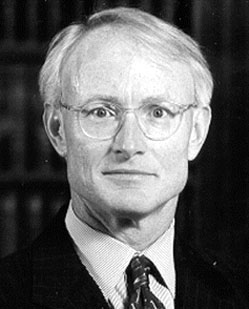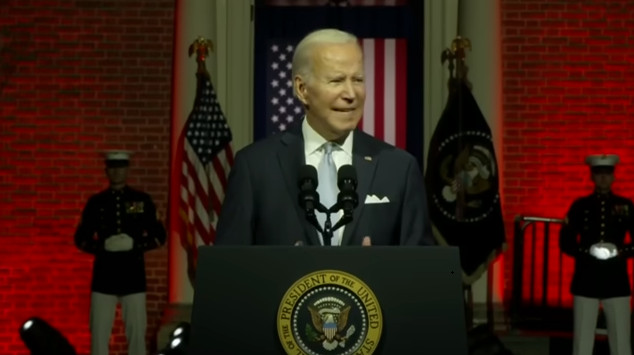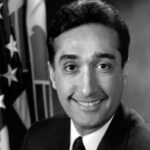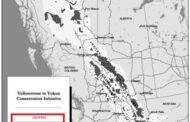President’s Council on Sustainable Development
Localization of Global Initiatives
PCSD Task Force Report on Population and Consumption (Introduction – html) Report PDF format, P.6
At the Earth Summit in Rio de Janeiro in June 1992, the largest gathering of heads of state in history, more than 120 nations agreed to a blueprint for global action called Agenda 21. The goal of Agenda 21 is to move the world toward economic activity that meets the needs of present generations without compromising the ability of future generations to meet their own needs-that is, toward “sustainable development.”
. . . To begin translating the vision of Agenda 21 into U.S. action, President Clinton created the President’s Council on Sustainable Development (PCSD) in June 1993.
When Joe Biden gave his speech on the Battle for the Soul of the Nation, he was right in proclaiming that the danger was fascism. The irony is that it was the democrats that converted the U.S. system of government to fascism making Biden’s warning about 30 years too late and pointing in the wrong direction.
The fascist organizational structure can be described simply as the cooperative business, government and “community” organizations established for cooperative central economic planning with regional cooperatives for transportation planning and “community cooperatives” for social planning and management. The incentives provided for community and regional “partnerships” removed the voting public’s voice from the power equation. Regional organization and “community partners” embedded in the Mayor’s office transfered power to unelected soviets – committees. The federal Administrative State along with the regional soviets are the fascist power in America.
See the Rocky Mountain Heist
The conversion to fascism was led by the President’s Council on Sustainable Development (PCSD) established in 1993. In a previous article titled, the Blueprint for Reinvention of Government, the fascist beginnings behind the Council were identified. The purpose of this article is to give the transmission path of fascism to our cities and counties that came through the work of the PCSD.
Tim Wirth, Co-Chair of the PCSD Task Force for Population and Consumption, State Department, Office of Global Affairs, One-man wrecking ball for the world.
President’s Council on Sustainable Development
Council Co-Chairmen:
David T. Buzzelli, Vice President, Dow Chemical
Jonathan Lash, President, World Resources Institute
The Council established task forces to be the steering committees for the areas of planning for the conversion. They were to conclude their work by April 1995 – but when that time rolled around, they were extended. The task forces produced preliminary reports and then continued their work.
In 1997, the Council produced an aggregated preliminary report. A hard copy of this report could not be found. It was in html format only on the archived Clinton White House website so it was copied to a Word document for ease of reading and printing. The title of the report is:
Building on Consensus: A Progress Report on Sustainable America
This link is to a copy of the report with highlights on important passages.
Page 4 – Letter to the President
• The Council has been working with the U.S. Conference of Mayors and the National Association of Counties to create the Joint Center for Sustainable Communities.
• Secretary Cisneros recently released a major report on metropolitan economic strategies, and the Department of Transportation has developed a proposal for the reauthorization of the Intermodal Surface Transportation Efficiency Act–a model of metropolitan-scale decisionmaking.
The Joint Center no longer has an active presence on the web, but some pages of the website were retrievable from the archives. As you are reading these pages, think about organizational structure and power.
Encouraging the development of metropolitan and rural regional compacts (or multi-jurisdictional partnerships) on issues such as urban sprawl and transportation management.
Joint Center Report, Summer 1997, Volume 1 – Number 1– these are one page articles reporting on the status of of the joint center initiatives – read them all.
Vice President Gore on the Joint Center and Sustainability:
“I’ve worked closely with the National Association of Counties and the U.S. Conference of Mayors to launch the Joint Center for Sustainable Communities. The Joint Center is beginning to provide city and county governments all across America with the tools and the know-how to bring this ethic of sustainability to every community in America.” “For local governments, one of the best ways to deepen the ethic of sustainability is to recognize the interdependence of urban cores and their surrounding metropolitan areas. We’re discovering that many problems transcend these jurisdictional boundaries and that cooperation rather than competition for scarce resources is the best solution for everyone.”
Cities, Counties and Community 2020: The Future of Metropolitan Regions
Building Regional Industry Clusters – central economic planning by your local yokel mayor and county officials in “partnership” with government, Chamber of Commerce and the largest businesses in your area.
HUD’s extensive field interviews in 114 regions found that metropolitan cooperation and civic leadership were the essential ingredients enabling cities and counties to develop effective regional strategies for enhancing economic prosperity and quality of life. Where these strategies are succeeding, they involve investing in: transportation and infrastructure; education and workforce development; research and technology; trade promotion and market development; financing; business development and attraction; economic and community revitalization; environmental preservation and restoration; reforming taxes and regulatory policies; and community amenities.
Metropolitan regions as economically different as Detroit, Atlanta and Portland (Ore.) are creating visions for change and are making successful transitions from older declining sectors to dynamic industry clusters that are competitive in the new economy.
For example, metropolitan Austin transformed its economy from a state government center to one of the nation’s premiere high-technology regions. Its metropolitan economic strategy focused on the University of Texas as the key resource for education, workforce development, research, and technology, attracting key computer industry research centers and spinning off dozens of homegrown firms, including Dell Computers.
This one is of particular interest to me:
The tool kit is part of a world wide web site launched last year by DOE’s Center of Excellence for Sustainable Development (CESD), an initiative designed to help municipalities understand and adopt sustainable development as a comprehensive approach to planning.
DOE’s interest in working with communities is simple: Cities and counties have an enormous impact on how the nation uses energy. In aggregate, local land-use patterns, transportation policies, building codes, municipal fleets and buildings, and dozens of other community practices have high impact on the type and amount of energy we consume as a nation. At the same time, energy use is critical to sustainable communities. No community can be healthy over the long haul if energy consumption soils the air and damages public health, wastes tax dollars, erodes the disposable incomes of its residents and steals profits from its industries.
Seeing Communities as Systems
Interest in sustainable community planning also seems to grow as more local leaders recognize it as a new way of thinking, not a community development fad of the 90s. Sustainable community planning–which engineers might call “systems thinking”–is the ability to see beyond isolated parts of community life, and to understand and influence how those parts interrelate. Communities seem to work better when they understand themselves as systems, rather than a series of unrelated crises.
That’s it. The Department of Energy.
To take our country back, you must understand how we lost it. We lost it through the implementation communist central planning of the economy and the infrastructure of our cities and counties instituted by the President’s Council on Sustainable Development (Agenda 21). We lost it through systems planning and it must be deconstructed systemically beginning with the fascist-led city-county-community-money cartels.
Transmission Path for Fascism
- city leaders–in the public sector, the private sector, and community-based groups–to work together with their counterparts in surrounding suburban and rural communities.
- The Council has been working with the U.S. Conference of Mayors and the National Association of Counties to create the Joint Center for Sustainable Communities.
PCSD Task Forces Preliminary Reports
Task Force Reports from the first phase of the PCSD. These reports were found only in html format so they were copied to Word documents for ease of reading.
Additional Task Forces Created
Task Force on Climate Change
Environmental Management Task Force
International task force
Metropolitan and Rural Strategies Task Force

Michael Porter, Mr. Cluster ****






